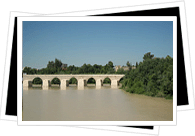 Aside from the main attractions featured in the different sections of Cordoba, here is a list of other attractions to make your list complete:
Aside from the main attractions featured in the different sections of Cordoba, here is a list of other attractions to make your list complete:
1. The Roman Bridge
The Puente Romano (Roman Bridge) crosses the Guadalquivir River. The bridge has 16 arches, and a statue of San Rafael (the town’s patron saint) can be seen in the middle of the bridge. At night, this scene is made even more romantic by the lights.
2. Bridge Gate
The Puerta del Puente (Bridge Gate) is at the north end of the Puente Romano. Built in 1571, it was finished during King Phillip II’s reign and was dedicated to him. This replaced a former Moorish gate.
3. Convento de la Merced
The original monastery was built during the 13th century. However, a fire destroyed the monastery’s church. And in the 18th century, the area was rebuilt. Of interest in the Convento are some important historical and artistic treasures, particularly the Visigothic baptistery and a painting of Christ that dates back from the 14th century.
Location: Plaza de Colon
4. Iglesia de Santa Marina
This church that looks more like a fortress because of its three massive pillars. So much so that it is often called the Fortress Church. Inside, you can see some important paintings and an altarpiece of Rosario Virgen.
Location: Santa Marina Square
5. Iglesia de San Pablo
Founded on the very day that Ferdinand III entered the gates of Cordoba (June 29, 1236). Like the other churches, it has three naves. This limestone structure also has a black baroque entryway that is quite a sight.
Location: Capitulares Street, close to the Roman Temple
6. Iglesia de San Andrés
This church has experienced so many “face-lifts” that its former style and personality have been more or less replaced. The only surviving reminders of the original design are the central apses and an entrance built in the Gothic style.
Location: San Pablo Street, San Andres Square
7. Iglesia de San Agustín
Again, this church was built by Ferdinand III. It also has the standard feature of three naves. Its interior features a splendid Plateresque style. Sadly, the frescos have only partly survived the ravages of time.
Location: Near Jesus Nazareno Street
8. Iglesia de San Lorenzo
Beautiful and magnificent. The interiors are definitely a must-see. You will be amazed at the Mudejar style paneling and the frescoes behind the main alter. This 10th century church, like many other churches at that time, is built in the grounds of a former mosque. In fact, its bell tower used to be the mosque’s minaret. There is also a rosette window on the west front.
Location: Capitulares Street
9. Iglesia de Santiago
This church was also built by Ferdinand III. However, because of a fire, the entrance gate and a few basic structures are all that remain of this church. The subsequent renovations show a newer style.
Location: Plaza de Augustin Moreno
10. Christ of the Pains (El Cristo de los Dolores)
Built by Friar Diego Jose of Cadiz, this is a monument of Christ on a stone cross. The monument has streetlamps providing illumination at night, thus the nick-name “Christ of the Lanterns”. The best time go here is at night.
Location: Cuesta de Bailio, near Alfaros Street
11. Seville Gate
The Seville Gate used to be a gate going into the Alcazar. During the Moorish era, a wall was built that served as the town’s protection. Sadly, only a stretch of the wall and some of the towers and gates remain. One such gate is the Seville Gate, which dates back to the 10th Century. Outside the gate stands a statue of Ibn Zaydun, one of Cordoba’s poets and writer of the treatise “The Dove’s Necklace”.
Location: Calle Puerta de Sevilla and Avenida del Corregidor
12. Palacio de Viana
A former residence of the Marquis of Viana, it now stands as a “museum of patios” because of 12 beautifully maintained courtyards. Inside the Renaissance palace, you will also find various historical treasures, such as tapestries, paintings, furniture, porcelains and so much more. The beauty of the palace has earned it its place as a National Monument.
Location: Plaza de Don Gome2
Opening Hours: 10:00 a.m. to 1:00 p.m., 4:00 p.m. to 6 p.m. (October to April)
13. Molino de Albolafia
This is a mill that stands near the north river back of the Guadalquivir. It supplied water to the Alcazar but Queen Isabella was annoyed with its noise and had it taken down. What you now see is the reconstruction of the mill.
Location: Near the Puente Romano